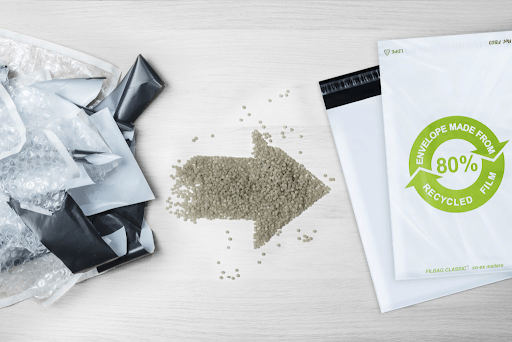

The world of e-commerce is booming. With convenience at our fingertips, online shopping has become an ingrained part of our lives. However, this surge in online purchases comes at a cost: increased carbon emissions from shipping and a significant increase in packaging waste. In 2021 alone, the average EU citizen produced almost 190kg of packaging waste. Oversized cardboard boxes, virgin-plastic peanuts, and air-filled pouches pile up in landfills, taking hundreds of years to decompose and releasing harmful toxins in the process.This is where recycled and recyclable shipping packaging steps in. It offers a sustainable solution to the growing problem of packaging waste, promoting a more responsible e-commerce experience. However, while we keep hearing about sustainability and the shift towards more sustainable shipping practices – why exactly does it matter? Let’s dive into this and explore five compelling arguments for embracing recycled and recyclable shipping materials…
Every year, millions of tons of non-recyclable packaging end up in landfills. These overflowing landfills not only occupy valuable space but can also contaminate surrounding soil and water sources with harmful chemicals, for example VOCs and HAPs coming from traditional inks, used for printing on shipping packaging.
Beyond the ecological damage caused by overflowing landfills, the issue of plastic pollution extends far beyond land. Millions of tons of plastic waste end up in our oceans every year, wreaking havoc on marine ecosystems. The problem is further compounded by microplastics – tiny plastic fragments formed from the breakdown of larger plastic items or shed from synthetic clothing. These microplastics are ingested by marine life throughout the food chain, including fish and shellfish that eventually end up on our plates. Research is ongoing to determine the potential health risks of microplastics on human health, but studies suggest they may disrupt hormone production and contribute to various health problems.
Moreover, manufacturing virgin packaging materials like cardboard and plastic requires significant non-renewable resources, including trees and water. Recycled materials, on the other hand, give these resources a second life. For example, producing one ton of virgin paper pulp requires around 2-4 tons of trees. By choosing recycled cardboard for shipping boxes, we can significantly reduce the number of trees cut down for paper production.
The recycling process itself also consumes less energy compared to virgin material production. For example, studies suggest that recycled paper production uses about 40% less energy than virgin paper production. This translates to a lower release of greenhouse gasses like carbon dioxide, a major contributor to climate change.
Recycled and recyclable plastic packaging plays a crucial role in minimizing the amount of plastic that enters our environment, extending its lifespan and minimizing energy consumption and environmental damage. By choosing recycled plastic packaging and prioritizing responsible waste management, we can help keep our oceans clean and safeguard the health of marine ecosystems and potentially our own.

Traditional packaging production processes are energy-intensive, releasing greenhouse gases like carbon dioxide into the atmosphere. These emissions contribute to climate change, leading to rising global temperatures, extreme weather events, and disruptions to ecosystems.
Recycled and recyclable packaging offers a significant reduction in carbon footprint. Recycling existing materials requires less energy compared to creating new ones from scratch. This translates to a lower release of greenhouse gasses, mitigating the impact on our climate. Another key aspect of the transition to net zero will be the efficient utilization of space – which in the reality of transport translates to less CO2 emissions. Cardboard boxes, with their inherent wastage of unused space, are becoming increasingly unsustainable, and smaller, more fitted shipping packaging like paper envelopes and recycled poly mailer bags, will gain on popularity, allowing to maximize the number of parcels per transport – and hence minimizing individual parcel’s carbon footprint.
An estimated 350 million tons of plastic waste is generated each year – and only 9% of plastic produced globally was ever recycled. This shows that we are still mostly living in a traditional, linear economic model where the approach towards resources follows a “take-make-dispose” rule: resources are extracted, used, and then discarded as waste. This linear model is unsustainable and contributes to environmental degradation.
A circular economy promotes a closed-loop system where materials are reused and recycled, minimizing waste and maximizing resource efficiency. Increasing recyclability and embracing a more circular economy is one of – if not the – most effective ways towards a cleaner and healthier planet.
Recycled and recyclable packaging embodies the principles of a circular economy. By using recycled materials and designing packaging for easy recycling, we close the loop on the life cycle of these materials. This not only reduces waste but also encourages innovation in sustainable packaging solutions.

Today’s consumers are increasingly environmentally conscious – and sustainability is no longer a niche concern, reserved only to the youngest generation.
A recent study by the IBM Institute for Business Value (IBV) in 2022 found that purpose-driven consumers, those who prioritize brands aligning with their values, now represent the largest consumer segment (44%). This trend transcends demographics – individuals across income levels and age groups are increasingly motivated to support sustainable practices.
Multiple studies have also shown a growing change not only in consumers’ mindsets but also their actions – in favour of the companies that use eco-friendly practices, including sustainable packaging. For example, a 2022 NielsenIQ study revealed that 73% of global consumers are willing to pay more for sustainable products.
As customers are increasingly making purchasing decisions based on a brand’s commitment to sustainability. By embracing recycled and recyclable packaging, businesses can demonstrate their commitment to environmental responsibility. This can be achieved by strategically integrating eco labels and certification logos alongside your logo and other elements of your company’s visual identity on the packaging, making it easier for customers to identify a company’s commitment to sustainability at a glance. It resonates with eco-conscious consumers, fostering brand loyalty and attracting new customers who support sustainable practices.
Highlighting the lesser environmental impact of using recycled mailers is a strategic way to appeal to potential clients concerned about sustainability. FILMAR’s approach offers a prime example of how businesses can incorporate environmentally friendly packaging solutions that align with consumer values. By emphasizing the reduced carbon footprint, waste reduction, and the use of recyclable materials, companies can position themselves as responsible choices for consumers looking to make a positive impact through their purchases. This commitment to sustainability can be a compelling selling point, particularly when communicated clearly and effectively in marketing materials.
Adding to the momentum for change are new regulations being implemented by the European Union (EU). The proposed revision of the Packaging and Packaging Waste Directive (PPWD), introduced in November 2022, aims to significantly transform the packaging landscape within the EU. Here’s how these regulations will accelerate the shift towards recycled and recyclable shipping packaging:

The environmental impact of e-commerce packaging is undeniable. However, transitioning to recycled and recyclable materials offers a powerful solution. By reducing waste, conserving resources, and promoting a circular economy, recycled and recyclable shipping packaging paves the way for a more sustainable future for e-commerce. As a business owner, you can support this shift by making informed choices and choosing more sustainable shipping packaging solutions – while at the same time gaining a competitive edge by demonstrating your commitment to environmental responsibility and attracting a growing segment of eco-conscious consumers. Together, we can create a more sustainable future for e-commerce, where convenience and environmental responsibility go hand in hand.
Embracing FILMAR’s recycled mailers aligns your business with these environmental goals, offering a practical, immediate step towards a more sustainable operational model.
Choose our certified eco-friendly mailers today:
